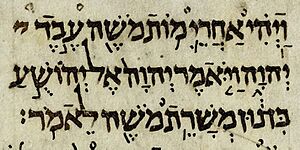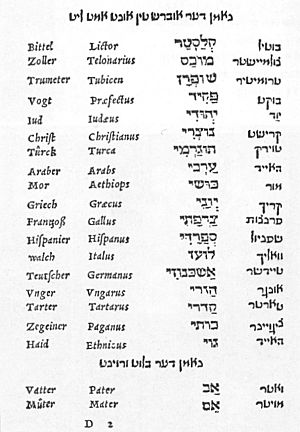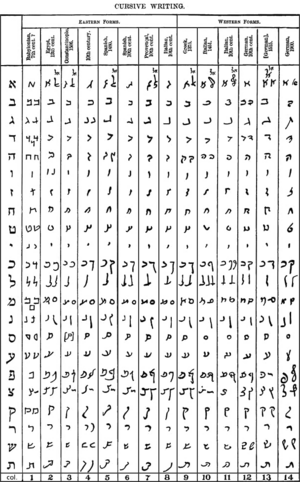History of the Hebrew alphabet facts for kids

The Hebrew alphabet is a special set of letters used to write the Hebrew language. It came from another alphabet called the Aramaic alphabet a long time ago, between about 500 BCE and 50 CE. This happened during big empires like the Persian, Hellenistic, and Roman times. Before this, people used an older script called the Paleo-Hebrew alphabet for early Hebrew writings.
Contents
The Story of the Hebrew Alphabet
It's important not to mix up the history of the modern Hebrew alphabet with the history of the Paleo-Hebrew alphabet. The Paleo-Hebrew alphabet is called that because it was used to write the very first forms of the Hebrew language. It's not because it's the direct ancestor of today's Hebrew letters.
The term "Paleo-Hebrew alphabet" is a modern name. It refers to the Phoenician alphabet when it was used by ancient Israelites. This script was common in the kingdoms of Israel and Judah. It was also used across Canaan from the 10th to 7th centuries BCE. Over time, this script changed into different versions. The most successful one was the Aramaic script, which became very popular in the Persian Empire.
After the Babylonian exile, Jewish people slowly stopped using the Paleo-Hebrew script. Instead, they started using a "square" version of the Aramaic alphabet. A similar "square Aramaic script" is still used today for some Aramaic languages.
This "square" Aramaic alphabet slowly became the Hebrew alphabet we know today. This change happened during the Second Temple period and finished around the 1st century CE. For example, the letter samekh got its closed, round shape around 100 BCE. This shape then became the standard in the 1st century CE.
However, the Samaritan alphabet is different. It is a direct descendant of the old Paleo-Hebrew script.
Over time, the Hebrew alphabet was also used to write other languages spoken by Jewish communities around the world. These include Karaim, Kivruli, Judæo-Arabic, Ladino, and Yiddish. Even with these changes, the Hebrew alphabet stayed mostly the same for writing Jewish law, holy books, and studies. It was also kept for the rebirth of Hebrew as a modern, everyday language starting in the 1700s and 1800s.
Ancient Jewish Beliefs About the Alphabet
In ancient Jewish texts called the Talmud, the Paleo-Hebrew script is known as Libona'a. This name is linked to the Samaritan community, who continued to use this script. The modern Hebrew script is called Ashurith, which means "Assyrian script."
Jewish wise people from the Talmud had different ideas about how the Hebrew alphabet developed. Some believed that Paleo-Hebrew was the first script used by the Israelites when they left Egypt. According to this idea, the block-like script seen in Hebrew Torah Scrolls today, called "Assyrian script," was the original one carved into the Ten Commandments.
Others thought that Paleo-Hebrew was only used for a short time. They believed the original script (the Hebrew alphabet) had been lost. In both these views, Ezra the Scribe (around 500 BCE) was important. They thought he brought back the Assyrian script to be the main alphabet for the Hebrew language. These ideas are based on Jewish holy writings and traditions.
A third idea in the Talmud says the script never changed at all. This wise person did not believe Paleo-Hebrew ever existed. This idea is based on a verse in the holy texts that talks about the shape of the letter vav. This sage also argued that because a Torah scroll must be copied exactly from another, the script could not have changed. Some early Jewish scholars accepted this idea, while others did not. This was partly because it was allowed to write the Torah in Greek.
How Letters Changed Over Time
| Letter | Name | Scripts | |||||||||||||||||
|---|---|---|---|---|---|---|---|---|---|---|---|---|---|---|---|---|---|---|---|
| Hebrew | Ancestral | Related | |||||||||||||||||
| Cursive | Rashi | Braille | Hieroglyphic base of Proto-Sinaitic (assumed) |
Proto-Sinaitic (reconstructed) |
Phoenician | Paleo-Hebrew | Aramaic | Greek | Latin | Cyrillic | Arabic | ||||||||
| א | Alef |
|
Αα | Aa | Аа | ا | |||||||||||||
| ב | Bet, Vet |
|
Ββ | Bb | Бб Вв |
ﺑ ﺏ | |||||||||||||
| ג | Gimel |
|
Γγ | Cc Gg |
Гг | ﺟ ﺝ | |||||||||||||
| ד | Dalet |
|
Δδ | Dd | Дд | دذ | |||||||||||||
| ה | Hei |
|
Εε | Ee | Ее Єє |
ه هـ ـهـ ـه |
|||||||||||||
| ו | Vav |
|
Υυ Ϝϝ |
FfUuVv WwYy |
Ѵѵ Уу |
ﻭ | |||||||||||||
| ז | Zayin |
|
Ζζ | Zz | Зз | ﺯ | |||||||||||||
| ח | Het |
|
Ηη | Hh | Ии | ﺣﺡ or خ | |||||||||||||
| ט | Tet |
|
Θθ | – | Ѳѳ | ﻁ | |||||||||||||
| י | Yud |
|
Ιι | Jj Ii |
Јј Іі |
ﻳ ﻱ | |||||||||||||
| כ | ך | Kaf, Khaf |
|
Κκ | Kk | Кк | ﻛ ﻙ | ||||||||||||
| ל | Lamed |
|
Λλ | Ll | Лл | ﻟ ﻝ | |||||||||||||
| מ | ם | Mem |
|
Μμ | Mm | Мм | ﻣ ﻡ | ||||||||||||
| נ | ן | Nun |
|
Νν | Nn | Нн | ﻧ ﻥ | ||||||||||||
| ס | Samech |
|
Ξξ Χχ |
Ss or Xx | Ѯѯ Хх |
ص or س | |||||||||||||
| ע | Ayin |
|
Οο | Oo | Оо | ﻋ ع غـ غ |
|||||||||||||
| פ | ף | Pei, Fei |
|
Ππ | Pp | Пп | ﻓ ﻑ | ||||||||||||
| צ | ץ | Tsadi |
|
Ϻϻ | – | Цц Чч |
ﺻ ص ضـ ض |
||||||||||||
| ק | Kuf |
|
Ϙϙ | Ҁҁ | ﻗ ﻕ | ||||||||||||||
| ר | Reish |
|
Ρρ | Rr | Рр | ﺭ | |||||||||||||
| ש | Shin, Sin |
|
Σσς | Ss | Сс Шш |
سـ س شـ ش |
|||||||||||||
| ת | Tav |
|
Ττ | Tt | Тт | ﺗ ﺕ ﺛ ﺙ |
|||||||||||||
Images for kids
-
A Jewish stone marker found near old walls in Serdica.
-
A copy of the Gezer Calendar, which is in the Israel Museum in Jerusalem.
See also
- Cursive Hebrew
- Rashi script
- Vaybertaytsh
- Solitreo
- Proto-Sinaitic alphabet
- Phoenician alphabet
- Paleo-Hebrew alphabet
- Aramaic alphabet





